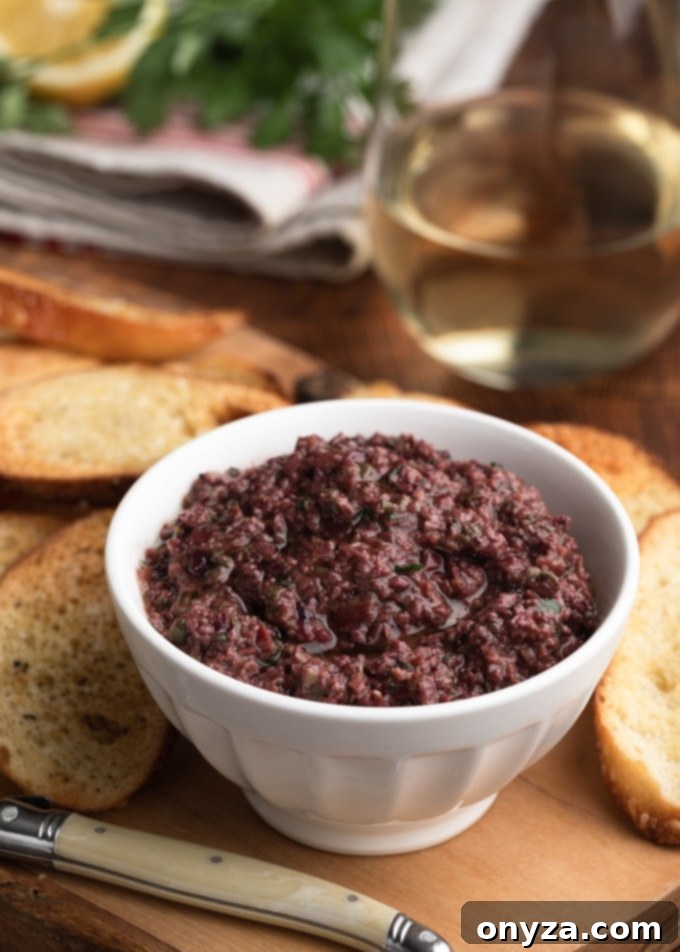In less than 10 minutes, you can effortlessly create a vibrant batch of homemade Black Olive Tapenade using your food processor! This Mediterranean classic, bursting with rich umami flavor, serves as an incredibly versatile and delicious ingredient perfect for elevating your appetizers, light meals, and dinner recipes.
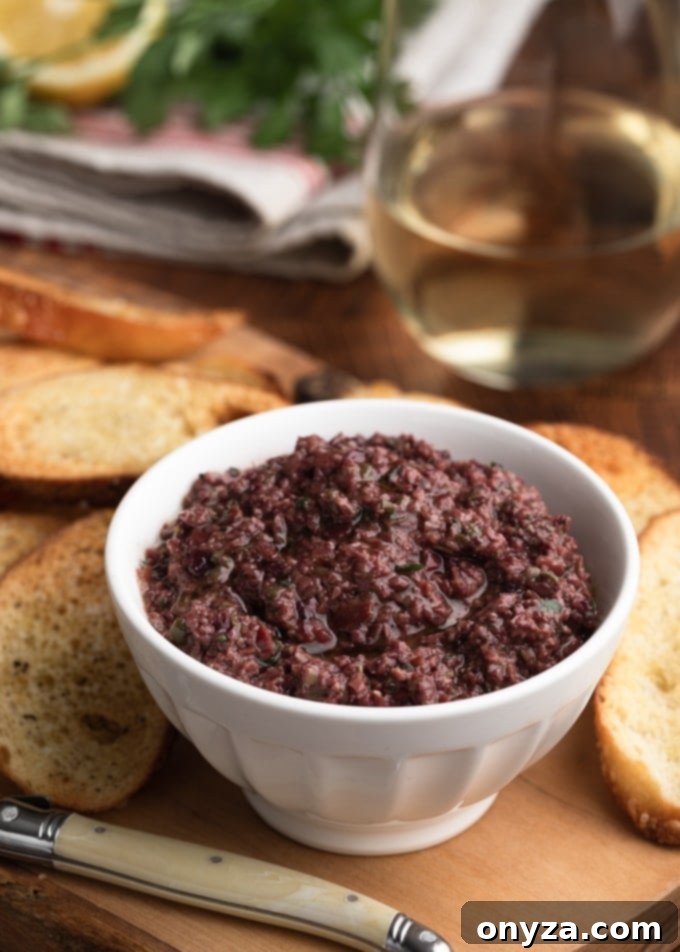
This post contains affiliate links. As an Amazon Associate, I earn a commission (at no additional cost to you) from qualifying purchases made by clicking these links. As always, all recommendations and opinions expressed are my own.
Have you ever found yourself in an unexpected surplus of ingredients after a grocery trip? Perhaps an extra bag of fresh produce or a forgotten container lurking behind a larger one in the fridge? Last week, that was my situation with olives. A classic oversight led to an abundance of these briny delights, far more than initially planned for!
But every culinary “problem” presents an opportunity, and for a surplus of olives, there’s no better solution than whipping up a fresh batch of tapenade. This deeply savory, salty, and wonderfully briny spread is not only a fantastic way to utilize extra olives but also a perennial crowd-pleaser that adds a touch of Provençal elegance to any meal. It’s a truly delightful concoction that transforms simple ingredients into an extraordinary burst of flavor.
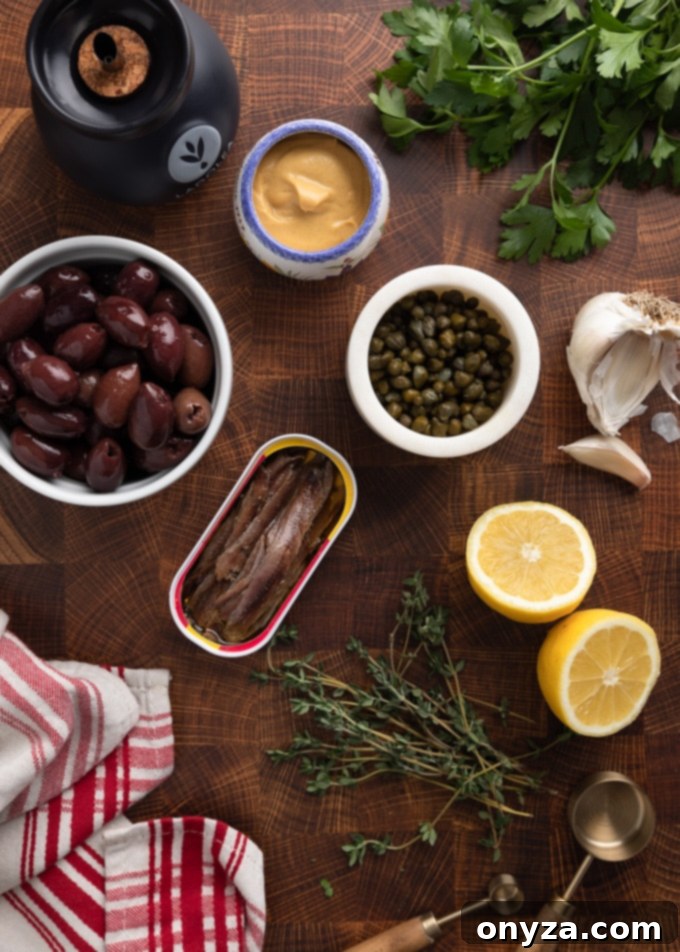
What Exactly is Tapenade?
While “utterly delicious” is an accurate, albeit informal, description, there’s much more to understand about tapenade. Originating from the sun-drenched region of Provence in Southern France, tapenade is a traditional olive-based paste or spread. At its heart, authentic tapenade is crafted from a harmonious blend of olives, capers, anchovies, and olive oil, creating a flavor profile that is both robust and complex.
Interestingly, despite olives being the predominant ingredient, the name “tapenade” actually derives from the Provençal word “tapenas,” which means “capers.” This linguistic tidbit, shared by a chef friend years ago, highlights the crucial role capers play in defining this iconic spread. Their pungent, salty notes are indispensable, providing a vital counterpoint to the richness of the olives and the umami depth of the anchovies.
In modern culinary discourse, you might encounter dishes labeled as “artichoke tapenade” or “red pepper tapenade” on restaurant menus or in gourmet food stores. While these spreads can be delicious in their own right, they technically diverge from the traditional definition. The term has, in popular usage, broadened to encompass various puréed vegetable spreads, much like “aioli” has become a generic descriptor for flavored mayonnaise, moving beyond its classic garlic-and-olive-oil emulsion roots. For purists, however, true tapenade always centers around olives and capers.
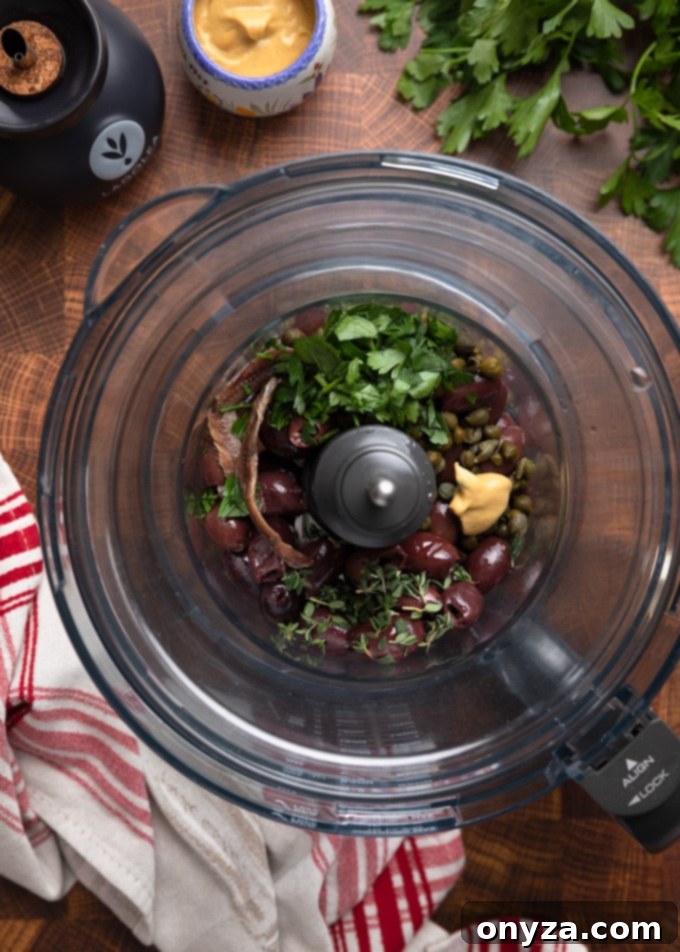
Crafting the Perfect Black Olive Tapenade: Key Ingredients
While the core components of tapenade remain consistent, recipes often feature subtle variations. Some purists adhere strictly to the classic olive-caper-anchovy-olive oil formula. However, many contemporary recipes, including this one, incorporate additional seasonings such as fresh garlic, aromatic herbs, a splash of bright lemon juice, and occasionally, a hint of Dijon mustard to enhance its flavor complexity.
For this rich and savory black olive tapenade, the choice of olives is paramount. I highly recommend using high-quality brine-cured olives like Kalamata or Niçoise. Kalamata olives offer a fruity, robust flavor and a tender texture, while Niçoise olives provide a milder, nuttier profile. Both varieties are fantastic choices, delivering the authentic taste and depth necessary for a superb tapenade. Ensure they are pitted for convenience.
Want to brush up on olive varieties? Explore the diverse world of olives with A Beginner’s Guide to Olives: 14 Varieties Worth Seeking Out from Serious Eats.
Don’t be daunted by the inclusion of oil-packed anchovy fillets in this recipe. A common misconception is that anchovies will impart an overly “fishy” taste. On the contrary, when blended into tapenade, they magically dissolve, contributing an incredible depth of savory umami flavor without any discernible fishiness. They are truly the secret weapon that elevates tapenade from good to extraordinary. Just two fillets are enough to transform the entire spread, adding a nuanced richness that can’t be replicated.
To ensure a balanced flavor profile, I always take the extra step of rinsing both the olives and capers before adding them to the food processor. Olives and capers are naturally salty due to their brining process. Rinsing them under cold water helps to remove excess salt, allowing you to control the overall seasoning of the tapenade more precisely. This prevents the spread from becoming overwhelmingly salty, ensuring each ingredient’s individual flavors can shine through.
For the garlic, a simple yet effective technique can significantly improve the final taste. Raw garlic, while potent, can sometimes be overly sharp or astringent. To mellow its bite, I mince the garlic clove and let it soak in the fresh lemon juice for about 10 minutes prior to blending. This brief marination process subtly tames the raw garlic’s intensity, resulting in a smoother, more integrated flavor in the tapenade. If you prefer a more assertive garlic punch, you can certainly skip this step and add the garlic directly with the other ingredients.
Fresh herbs are essential for adding brightness and aromatic complexity. I love using a combination of fresh thyme leaves and parsley for their earthy and fresh notes. During the warmer months, fresh basil leaves make a wonderful alternative or addition, infusing the tapenade with a fragrant, summery essence. A small amount of Dijon mustard (optional) can also be added for an extra layer of sharp, tangy depth, especially if your olives are on the milder side.
Finally, the quality of your extra-virgin olive oil makes a noticeable difference. Use a good quality oil that complements the rich flavors of the other ingredients, binding everything together into a luscious, spreadable paste. A drizzle of freshly ground black pepper (optional) at the end can further enhance the savory notes.
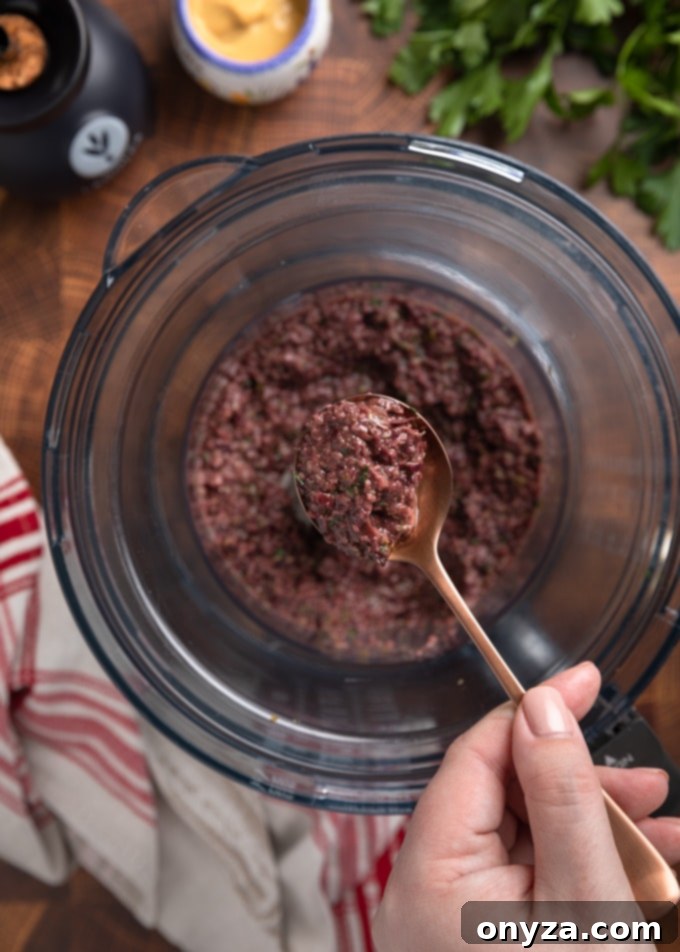
Effortlessly Crafting Your Tapenade: A Step-by-Step Guide
While the traditional method for making tapenade involves meticulously pounding the ingredients in a mortar and pestle to achieve a rustic paste, modern convenience offers a much faster and equally effective alternative: the food processor. For those who appreciate the texture and ritual, a mortar and pestle will yield a wonderfully authentic result. However, for everyday ease and speed, the pulse function of a food processor is your best friend.
Readers often ask me what food processor I use in my kitchen. I love my Breville Sous Chef. I’ve had the 16-cup model for several years, which also comes with a 2.5-cup mini bowl that fits inside of the larger bowl. (Pictured in this post.) It’s a powerful and versatile tool for countless kitchen tasks.
The process is incredibly straightforward. Begin by ensuring your olives, capers, and anchovies are thoroughly drained, rinsed, and gently patted dry. This crucial step, as mentioned earlier, helps manage the overall salinity of the tapenade. If you chose to pre-soak your garlic in lemon juice, set that aside for a moment.
Next, combine the prepared olives, capers, anchovy fillets, and the optional Dijon mustard in the bowl of your food processor. Use the pulse function in short bursts. The goal here is not a smooth purée but rather a coarsely chopped mixture. Stop periodically to scrape down the sides of the bowl with a spatula, ensuring all ingredients are evenly processed.
Once the initial ingredients are coarsely chopped, add the garlic-lemon juice mixture (if you pre-soaked it), fresh thyme leaves, and parsley. Pulse a few more times to just combine everything. This helps to integrate the fresh aromatics without over-processing the olives.
Finally, with the food processor running on a low setting or pulsing slowly, gradually drizzle in 2 to 4 tablespoons of good quality extra-virgin olive oil. The amount of olive oil needed can vary depending on the moisture content of your olives and your desired consistency. Continue to process until you achieve a thick, spreadable paste with a medium-to-coarse texture. Some small chunks are desirable for an authentic, rustic feel. Taste and adjust seasoning with freshly ground black pepper as needed (additional salt is usually not required due to the briny ingredients).
Storage Tips for Freshness
Once prepared, transfer your homemade tapenade to a tightly covered container and store it in the refrigerator. A glass jar with a clip-top or hinged lid works perfectly. It will keep fresh for up to 5 days. You might notice the olive oil solidifying slightly when chilled; this is completely normal. For the best flavor and texture, remember to bring the tapenade back to room temperature before serving. This allows the oil to soften and the flavors to fully bloom, enhancing its deliciousness.
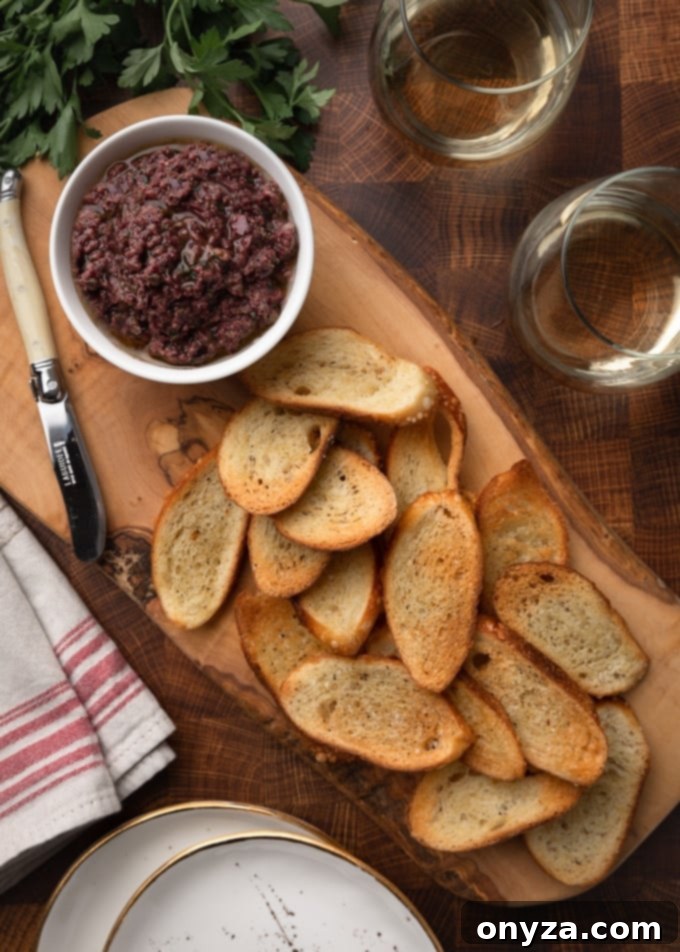
Elevate Your Meals: Our Favorite Ways to Enjoy Tapenade
Tapenade is far more than just a dip; it’s a culinary chameleon that can effortlessly transform a simple meal into something extraordinary. Its robust, savory profile and versatile texture make it an indispensable ingredient in any kitchen. Here are some of our favorite ways to incorporate this delightful olive spread:
Appetizers and Snacks:
- Classic Crostini: The most iconic way to serve tapenade! Simply spread it generously over crispy crostini, baguette slices, or crackers for an elegant and flavorful hors d’oeuvre. It’s a fantastic year-round snack, especially delightful with a glass of crisp white wine.
- Crudités Dip: Pair tapenade with a colorful array of fresh vegetables like carrot sticks, cucumber slices, bell pepper strips, and cherry tomatoes for a healthy and satisfying snack.
- Charcuterie Boards: A small bowl of tapenade is a sophisticated addition to any cheese or charcuterie board, complementing cured meats, aged cheeses, and crusty bread beautifully.
- Deviled Eggs Upgrade: Stir a teaspoon of tapenade into your deviled egg filling for an unexpected burst of Mediterranean flavor and a lovely color contrast.
Main Courses and Light Meals:
- Pasta Perfection: Toss tapenade with hot pasta for a quick and incredibly flavorful meal. I particularly love to sauté cherry tomatoes and artichoke hearts, then combine them with bucatini and a few generous spoonfuls of tapenade for a vibrant and hearty dish.
- Stuffed Chicken or Fish: Use tapenade as a flavorful stuffing for chicken breasts or fish fillets like salmon or baked cod. Simply spread a thin layer over the meat or fish before rolling or baking, sealing in moisture and adding immense flavor.
- Lamb’s Best Friend: Tapenade pairs exceptionally well with lamb chops or roasted leg of lamb, offering a rich, salty counterpoint to the meat’s savory notes.
- Sandwiches and Wraps: Elevate your ordinary sandwich or wrap by spreading a thin layer of tapenade on the bread or tortilla. It adds a gourmet touch to turkey, ham, or vegetarian options.
- Pizza Base or Topping: Use tapenade as a unique base sauce for individual pizzas or dollop it onto freshly baked pizzas right before serving for an intense flavor boost.
However you choose to enjoy it, remember that tapenade is a complex, deeply-flavored recipe. A little bit goes a long way in delivering that signature Provençal taste. Experiment and discover your own favorite ways to incorporate this culinary gem into your repertoire!
CRAVING MORE? Subscribe to my newsletter and join me on Facebook, Pinterest, and Instagram for the latest recipes and news.
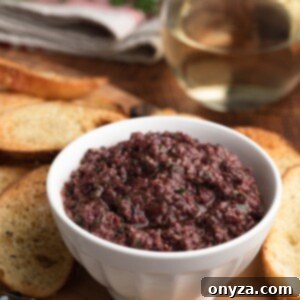
Black Olive Tapenade
Ingredients
- ½ pound pitted brine-cured Kalamata or Niçoise olives
- 2 tablespoons capers
- 2 oil-packed anchovy fillets
- 1 garlic clove , peeled
- 1 tablespoon fresh lemon juice
- 1 teaspoon Dijon mustard (optional, if you like a little extra sharpness – depending on your olives)
- 2 teaspoons fresh thyme leaves
- 1 tablespoon chopped fresh parsley leaves (optional)
- 2-4 tablespoons extra-virgin olive oil
- freshly ground black pepper , to taste (optional)
Instructions
- (Optional) Mince the garlic and combine it with the lemon juice in a small bowl. Let stand for about 10 minutes (This will reduce the harsh bite of the raw garlic in the tapenade – if you like a more assertive garlic flavor, skip this step and add the garlic and lemon juice with the olives in the food processor.)
- Drain, rinse, and pat dry the olives, capers, and anchovies. Place them in the bowl of a food processor, with the Dijon mustard (if using). Use short pulses to coarsely chop the mixture, scraping the bowl as needed.
- Add the garlic/lemon juice mixture, thyme, and parsley. Pulse a few times to combine. Add enough olive oil in a steady stream while pulsing to create a thick, medium- to coarse-textured, spreadable paste.
- Season to taste with pepper (optional), stirring to combine. Store, covered, in the refrigerator for up to 5 days. Return to room temperature before serving.
Notes
Nutrition Estimate
Nutrition information is automatically calculated, so should only be used as an approximation.
Please note that our recipes have been developed using the US Customary measurement system and have not been tested for high altitude/elevation cooking and baking.
